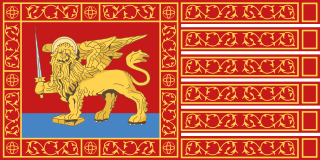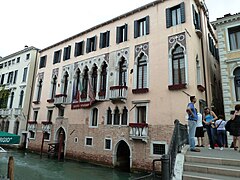
The Duchy of Athens was one of the Crusader states set up in Greece after the conquest of the Byzantine Empire during the Fourth Crusade as part of the process known as Frankokratia, encompassing the regions of Attica and Boeotia, and surviving until its conquest by the Ottoman Empire in the 15th century.

The Republic of Venice, officially the Most Serene Republic of Venice and traditionally known as La Serenìssima, was a sovereign state and maritime republic with its capital in Venice. Founded, according to tradition, in 697 by Paolo Lucio Anafesto, over the course of its 1,100 years of history it established itself as one of the major European commercial and naval powers. Initially extended in the Dogado area, during its history it annexed a large part of Northeast Italy, Istria, Dalmatia, the coasts of present-day Montenegro and Albania as well as numerous islands in the Adriatic and eastern Ionian seas. At the height of its expansion, between the 13th and 16th centuries, it also governed the Peloponnese, Crete and Cyprus, most of the Greek islands, as well as several cities and ports in the eastern Mediterranean.
Chiara Zorzi or Giorgio, also Clara or Claire, was duchess consort of Athens by marriage to Nerio II Acciaioli, Duke of Athens, and regent of Athens during the minority of her son Francesco I from 1451 until 1454.
Bartolomeo Contarini was a Venetian businessman who married the widowed duchess of Athens Chiara Zorzi in 1453 and governed the duchy in the name of her infant son, Francesco I.
The margraviate or marquisate of Bodonitsa, today Mendenitsa, Phthiotis, was a Frankish state in Greece following the conquests of the Fourth Crusade. It was originally granted as a margravial holding of Guy Pallavicini by Boniface, first king of Thessalonica, in 1204. Its original purpose was to guard the pass of Thermopylae.
Francis Zorzi (1337–1388), called Marchesotto, was a member of the Venetian Zorzi family and the Marquess of Bodonitsa in Central Greece from 1345 to his death.
Nicholas II Zorzi or Giorgi was the Margrave of Bodonitsa, a member of the Zorzi family of the Republic of Venice, from 1410 to 1414. He was the last Venetian margrave to actually rule before the Ottoman Turkish conquest.
Nicholas ΙΙΙ Zorzi or Giorgi was the Marquess of Bodonitsa, a member of the Zorzi family of the Republic of Venice, from 1416 to 1436, though the title was purely nominal by then. Before becoming marquess in an exchange with his nephew Nicholas II, he was the baron of Carystus. He was a son of Guglielma Pallavicini and Marquess Nicholas I Zorzi.
Nicholas I Zorzi was a Marquess of Bodonitsa, and the first member of the Zorzi family of Venice to hold the post, from 1335 to his death. In 1335, he married Guglielma Pallavicini, heiress of Bodonitsa and widow of Bartolommeo Zaccaria.

The House of Pallavicini, also known as Pallavicino and formerly known as Pelavicino, is an ancient Italian noble family founded by Oberto II Pelavicino of the Frankish House of Obertenghi.

Guglielma Pallavicini, the Lady of Thermopylae, was the last Pallavicino heir to rule in Bodonitsa, in Frankish Greece.

Louis Fadrique a Catalan nobleman who was Count of Salona, as well as lord of various other towns in Central Greece from ca. 1365 until his death in 1382. In 1375–1381 he also served as the vicar-general of the twin duchy of Athens and Neopatras.
Jacob Zorzi was the Marquess of Bodonitsa from 1388 to 1410. He was the last considered true ruler of the Frankish state of Bodonitsa.
Juan de Urtubia was a Navarrese royal squire who led first a contingent of fifty men-at-arms on an expedition to recover the Kingdom of Albania (1376–1377) and later a large army against Thebes and Boeotia, which he conquered in 1379.

The Frankokratia, also known as Latinokratia and, for the Venetian domains, Venetokratia or Enetokratia, was the period in Greek history after the Fourth Crusade (1204), when a number of primarily French and Italian states were established by the Partitio terrarum imperii Romaniae on the territory of the dismantled Byzantine Empire.
Zorzi is an Italian surname. Notable people with the surname include:

Mendenitsa, in the Middle Ages known as Mountonitsa (Μουντονίτσα) and Bodonitsa, Boudonitsa, or Vodonitsa (Βοδονίτσα), is a village in Phthiotis, Greece. Along with the nearby village of Karavidia, it forms a community in the municipal unit of Molos.

The Marquisate or Margraviate of Mantua was a margraviate centered around the city of Mantua in Lombardy. Ruled by the Gonzaga family from its founding in 1433, it would later be raised to the rank of Duchy in 1530.
This is an alphabetical index of people, places, things, and concepts related to or originating from the Republic of Venice. Feel free to add more, and create missing pages.
Nicholas Zorzi may refer to:











